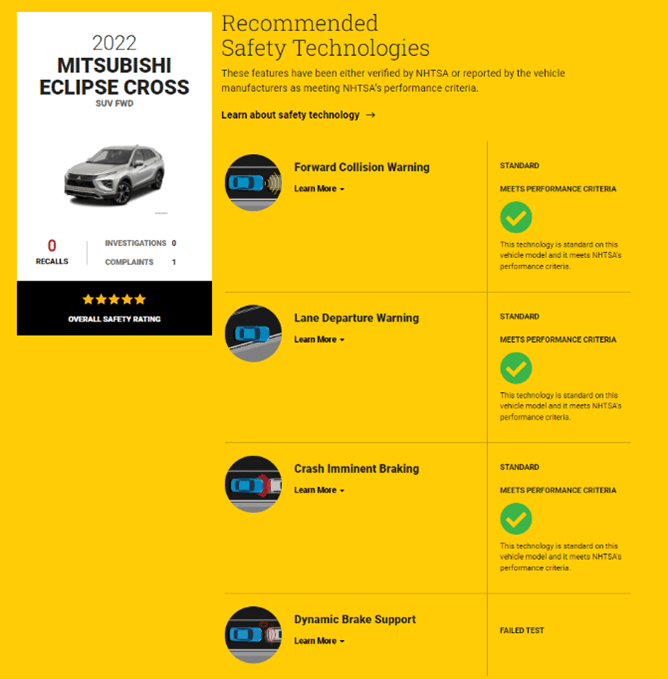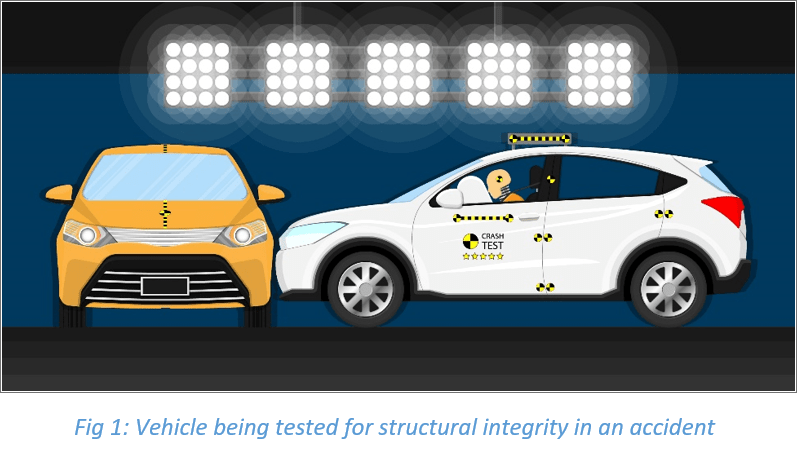The Previous Era of Accident Protection – Structural Integrity and Vehicle Mechanics
Historically, road safety has been driven by innovations such as airbags, seat belts, increased robustness of the vehicle frame and improved vehicle stability. A new car assessment program tests new vehicles that enter the market on a variety of factors and awards a score or a rating to a vehicle based on how well it has performed against those assessment tests. The better the performance, the better the rating. NCAP testing involves not only the mechanical and structural integrity of vehicles upon impact but also their ability to avoid rollovers and crashes.
Structural integrity tests consist of side impact tests, rear-end crashes and head-on frontal crash tests among others. Rollover resistance tests measure the ability of a vehicle to protect its occupants in the event of a vehicle rollover are another example of tests that vehicles must go through prior to release to the market. Such structural integrity and vehicle stability tests are a significant component of NCAP testing and will continue to remain so.
Moving From Accident Protection to Accident Avoidance
While structural integrity and vehicle stability are and will remain a critical part of NCAP, technology will lead the next advancements in road safety. ADAS features will power the next stage in enabling safer roads and reducing accidents, injuries and fatalities. This next leap in safety is marked by a shift from accident protection to an accident avoidance mindset and the pillar of these technological changes is sensor fusion and perception technology that has enabled advanced driver assistance systems (ADAS) such as blind spot warning, lane departure warning and forward collision warning. Great leaps in fusion and perception technology have enabled the development and testing of ADAS in new car assessment programs across the world.
In total, there are 12 new car assessment programs across the world, each catering to its specific region and needs. NCAP programs across the world are at different levels of maturity regarding ADAS adoption. Leading ADAS adoptions are U.S. NCAP and Euro NCAP, with both regions bringing updates to their assessment programs. Europe is poised to witness new NCAP regulations coming in 2025 that cover even more ADAS features in addition to the ones already included in the program. Similarly, the U.S.A. is also poised to revamp its new car assessment program to widen ADAS testing.
ADAS in NCAP
Some of the ADAS technologies that are currently part of new car assessment programs are adaptive cruise control, lane support system and automated emergency braking system for Euro NCAP and forward collision warning, dynamic brake support, crash imminent braking and lane departure warning for U.S.A. NCAP.

In early 2022, the National Highway Traffic Safety Administration (NHTSA) proposed updates to its new car assessment program. It provided the rationale behind these proposed updates, explaining how many lives and serious injuries could be avoided by engaging ADAS features on the vehicle and tightening testing criteria for ADAS features. This trend of increased ADAS adoption, testing criteria tightening and subjecting vehicles to more varied tests will accelerate putting more demands on sensor fusion and perception software stack. A perception software stack that is scalable (to enable future ADAS feature development), high-performing, sensor-agnostic (to incorporate radar, LiDAR, camera, ultrasonic) and cost-effective will be key to delivering strong results for OEMs and Tier 1s during NCAP testing.

Fig 2: Vehicles’ ADAS performance under USA NCAP
Source: nhtsa.gov
With a view to enhancing safety and making roads safer, LeddarTech welcomes the proposed changes and goes as far as to recommend making vulnerable road users such as bicyclists, motorcycles and pedestrians a key element of its ADAS-driven NCAP changes. LeddarTech is excited to see the proposed inclusion of pedestrian AEB in U.S. NCAP and would welcome expanding the program to cover additional scenarios and use cases.
Click HERE to see Part Two of this two-part white paper series.
This White Paper does not constitute a reference design. The recommendations contained herein are provided “as is” and do not constitute a guarantee of completeness or correctness. LeddarTech® has made every effort to ensure that the information contained in this document is accurate. Any information herein is provided “as is.” LeddarTech shall not be liable for any errors or omissions herein or for any damages arising out of or related to the information provided in this document. LeddarTech reserves the right to modify design, characteristics and products at any time, without notice, at its sole discretion. LeddarTech does not control the installation and use of its products and shall have no liability if a product is used for an application for which it is not suited. You are solely responsible for (1) selecting the appropriate products for your application, (2) validating, designing and testing your application and (3) ensuring that your application meets applicable safety and security standards. Furthermore, LeddarTech products are provided only subject to LeddarTech’s Sales Terms and Conditions or other applicable terms agreed to in writing. By purchasing a LeddarTech product, you also accept to carefully read and to be bound by the information contained in the User Guide accompanying the product purchased.
Download Complete White Paper in PDF Format





